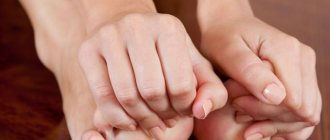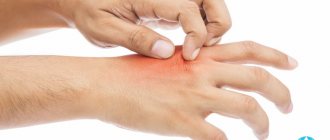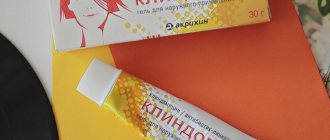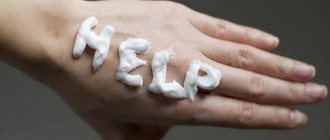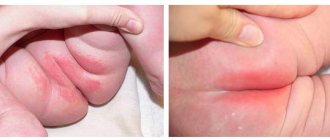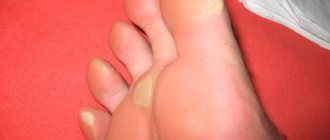Watery blisters on the skin of the hands: What is it?
Watery blisters on the hands are small formations protruding above the skin level, the diameter of which does not exceed half a centimeter. They differ from healthy skin in color and in most cases are red or pinkish in color. Inside, such rashes are filled with clear (serous) or bloody fluid.
When rubbed or pressed, the bubbles can burst, leaving a wound in their place. This most often occurs with blisters on the palms of the hands when a person wipes their hands, grasps a door handle, or performs other daily activities.
Typically, the appearance of watery blisters on the fingers or toes is preceded by redness of the skin, possibly peeling and increased sensitivity. Also, the rash is sometimes accompanied by swelling, burning and itching.
Before you begin treatment for the disease, you need to accurately determine the cause of the rash. As a rule, when the cause is eliminated, the rash goes away quite quickly: usually within a few days, sometimes longer. Let us list the main reasons that cause such a reaction.
Allergy
Watery blisters between the fingers, palms and hands can be a manifestation of an allergy to cosmetics, the sun or chemicals. In this case, itchy pimples appear exactly in the place that came into contact with the allergen. Most often these are fingers or palms, but sometimes also wrists (the reaction can occur, for example, to a watch strap).
The blisters may be painful, itchy, and crusty. This is quite dangerous: damage to the crust can lead to purulent infection. Without treatment, the rash can grow, coalesce, and affect more and more of the skin.
Infectious diseases
Watery blisters on the hands can be a symptom of an infectious disease. If the red rashes are very itchy and spread from the palms of the hands to the stomach and legs, there is a possibility that the patient has scabies. Such blisters can appear after a scabies mite bite or as a result of contact with a sick person in a public place. Scabies is a very painful and contagious disease, so it needs to be treated urgently.
Often, a rash on the hands can be a consequence of other infectious diseases: chickenpox, rubella, measles, enterovirus infection, etc. These diseases are thought to affect children more often, but in fact, teenagers and adults can also become infected. Depending on the type of disease, the rash may vary in shape and size. These can be small subcutaneous pimples or larger ones with pus.
If, in addition to rashes, a person feels unwell, has a fever and a headache, the likelihood of an infectious disease increases. Call a doctor immediately!
Internal diseases
Disorders of the gastrointestinal tract (gastritis, ulcers and other diseases) also affect the condition of the skin. Exacerbation of such diseases can lead to skin rashes in the form of small, fluid-filled blisters. This indicates the accumulation of toxins in the body or metabolic disorders.
Treatment of blisters on the hands in these cases should be comprehensive. First of all, you need to cleanse the body of toxins and restore the functioning of the gastrointestinal tract. Local treatment for this reason will not work.
Skin diseases
Rashes with clear liquid may also indicate fungal diseases. Along with the rash, the skin may become dry, red, and flaky. Another symptom of fungus is severe itching. At the slightest suspicion of a fungus, you should immediately contact a dermatologist, as the disease can infect your loved ones.
External reasons
Blisters on the skin may be a reaction to thermal burns from hot water, steam, iron or other devices. Burned skin usually feels hot and sore and red. After some time, a bubble forms at the burn site.
What are blisters?
A blister is a bandless pathological element that occurs as a result of an acute inflammatory process in the papillary layer of the dermis (that is, in the skin). Such formations do not have a cavity inside that is filled with liquid.
For your information, a blister differs from a vesicle in that it is not filled with exudate. However, outside medical circles these terms are not differentiated, so blisters are often called blisters and vice versa.
The bubble is filled with content. It can be transparent, purulent, or mixed with a blood component. Blisters vary in size depending on the etiology of formation. There are small ones, about 2-5 millimeters in diameter, or several centimeters.
According to medical literature, a blister is a certain elevation above the surface of the skin, which has clear boundaries. Such neoplasms arise instantly, and in most cases they disappear on their own without the use of specific treatment or medications.
Some medical experts argue that inflammatory formations in the upper dermal papillae should be considered blisters. But the bulges caused by abrasions, burns, etc., are blistered. However, it is easier to group these manifestations under the term blisters.
Features of blisters:
- Blisters are white or pink. They have sharp edges and often have a red or pink rim;
- The shape is always different. They can be round, oval, oblong, or irregular in shape. It always has a dense consistency to the touch.
In most clinical pictures, the vesicles/blisters are very itchy and there is pain when pressed. Do not scratch the affected area as this may cause infection.
Treatment
If you have itchy, watery blisters on your hands, seek help. The more severe the rash, the more often they are accompanied by a deterioration in general condition and an increase in temperature. If the blisters grow, turn red and hurt (possibly even fester), and the area around them swells, it is better to call an ambulance, as there is a high probability of infection.
In any case, only a doctor will determine the exact cause of the disease and tell you how to treat the blisters on your fingers. Don't panic: in the vast majority of cases, rashes go away as soon as the cause of their occurrence is eliminated. This may happen in a few days or weeks.
Treatment of the disease is chosen after diagnosis. If the cause of the itchy rash is scabies, it will be treated with external medications within a week. The therapy uses sulfur ointment for watery blisters on the hands and other medications.
If the rash in children or adults is caused by chickenpox, the patient may be hospitalized. For mild forms, treatment is possible at home. Patients are recommended antiviral and antipyretic drugs and local remedies that dry out pimples.
Fungal blisters are treated with topical creams and ointments. They are used to treat the affected areas. Often such drugs are toxic, so only a doctor should select them.
If watery blisters on the hands become an allergic reaction, treatment will be carried out using antihistamines: internal and external.
In any case, you should not diagnose yourself. This can only harm you. Let your doctor determine the cause of the problem and tell you what to do.
Causes
The reasons for the development of pemphigus have not yet been fully studied. One of the main causes of pemphigus is a violation of autoimmune processes, thereby the cells become antibodies to the immune system.
Violation of cell structure is subject to the influence of external factors, as well as aggressive environmental conditions. As a result, the communication between cells is disrupted, which leads to the formation of bubbles. The incidence rate in people with a hereditary predisposition is much higher.
Cream La-Cri for sensitive skin of hands
Whatever the cause of the lesion, the skin suffers in any case. Patients experience increased sensitivity to cosmetics and chemical components, so they are advised to abandon conventional cosmetics and give preference to neutral hygiene products.
Special La-Cri products will help fight inflammation and provide gentle skin care. Instead of regular soap, it is better to switch to a soft cleansing gel that is suitable for the entire body and face. After washing, the skin can be lubricated with anti-inflammatory and softening cream.
The La-Cri skin care series is developed on the basis of natural ingredients (healing oils, panthenol, plant extracts). These products do not contain hormones, dyes, fragrances or parabens, so they can be regularly used by children from the first days of life and by adults with sensitive skin. Such cosmetics will help speed up treatment and restore skin faster.
To prevent relapse, lead a gentle lifestyle. Try to get rid of bad habits, maintain hygiene, avoid contact with chemicals (wear gloves).
Medicines for the treatment of pemphigus
The patient is advised to take glucocorticoids in high doses. The following drugs can be used for this:
- Metipred;
- Prednisolone;
- Dexamethasone;
- Polcortolon.
When symptoms begin to regress, the doses of these drugs are gradually reduced to the minimum effective. Patients with pathologies of the gastrointestinal tract are prescribed long-acting glucocorticoids:
- Metipred-depot;
- Diprospan;
- Depo-Medrol.
Treatment with hormonal drugs can cause a number of complications, but they are not a reason to discontinue corticosteroids. This is explained by the fact that refusal to take them can lead to relapses and progression of pemphigus.
Possible complications during treatment:
- acute psychosis;
- arterial hypertension;
- depressive states;
- insomnia;
- increased excitability of the nervous system;
- steroid diabetes;
- thrombosis;
- obesity;
- angiopathy;
- erosions or ulcers of the stomach and/or intestines.
If the patient’s condition sharply worsens while taking corticosteroids, the following measures may be recommended:
- diet: limiting fats, carbohydrates and table salt, introducing more protein and vitamins into the diet;
- drugs to protect the gastric mucosa: Almagel, etc.
In parallel with glucocorticoids, cytostatics and immunosuppressants are prescribed to increase the effectiveness of therapy and the possibility of reducing doses of hormonal agents.
The following medications can be used for this:
- Sandimmune;
- Methotrexate;
- Azathioprine.
To prevent electrolyte imbalance, the patient is recommended to take calcium and potassium supplements. And for secondary infection of erosions - antibiotics or antifungal agents.
The ultimate goal of drug therapy is to make the rash disappear.
Clinical researches
The conducted clinical study proves the high efficiency, safety and tolerability of products for daily skin care of children with mild and moderate forms of atopic dermatitis and during remission, accompanied by a decrease in the quality of life of patients. As a result of therapy, a decrease in the activity of the inflammatory process, a decrease in dryness, itching and flaking was noted.
The composition of La Cree cream for sensitive skin includes:
- Violet extract and bisabolol (the active ingredient of chamomile) have an anti-inflammatory and soothing effect;
- Extracts of string and licorice have anti-inflammatory properties, have an antipruritic effect, relieve redness and flaking of the skin;
- Walnut extract has antimicrobial, anti-inflammatory and healing effects.
- Panthenol and avocado oil have a regenerating and softening effect, nourish and moisturize the skin.
The conducted clinical study proves the high efficiency, safety and tolerability of products for daily care of children's skin, including skin with mild and moderate forms of atopic dermatitis and during remission, accompanied by a decrease in the quality of life of patients. As a result of therapy, a decrease in the activity of the inflammatory process, a decrease in dryness, itching and flaking was noted.
Sources:
- Sukolin Gennady Ivanovich, Illustrated clinical dermatology. Brief alphabetical reference book, publishing house Lux Print, 2010
- Chapman M. Shane, Habiff Thomas P., Zug Catherine A., Dinoulos James G. H., Campbell James L., Dermatology. Handbook of differential diagnosis, publishing house: MEDpress-inform, 2014
- Molochkova Yulia Vladimirovna, Dermatology. Brief reference book, publishing house: GEOTAR-Media, 2017
Treatment of viral pemphigus
Treatment of viral pemphigus involves the use of the following systemic drugs:
- cytostatics stop the division of immune cells: Sandimmune, Azathioprine, Methotrexate;
- antiviral: Viferon, Laferon, Cycloferon;
- glucocorticosteroids: Dexamethasone, Prednisolone;
- antipyretics: Ibuprofen, Paracetamol, Nimesil, Mefenamic acid;
- antihistamines relieve itching: Cetrin, Diazolin, Fenistil.
For external treatment of affected skin areas, the following may be prescribed:
- antimicrobial local anesthetics for irrigating the oral cavity if viral pemphigus has affected the child’s mucous membranes: Forteza, Orasept;
- antiseptics: Chlorhexidine, Methylene blue, Miramistin;
- combination preparations of antiseptics and anesthetics: Oflokain, pharmaceutical talkers;
- antipruritic lotions made from nettle juice, aloe, and walnut oil.
Since children with this diagnosis are usually treated in a hospital setting, to enhance the therapeutic course, therapeutic procedures can be carried out aimed at clearing the blood of antibodies:
- plasmapheresis - replacement of the liquid part of the blood with similar solutions without microbes, immune complexes and antibodies;
- hemosorption using a carbon filter.
Only a doctor can tell how to treat viral pemphigus, because in each individual case it can acquire some special features. As for other forms of pemphigus, the therapeutic course for them is also determined individually.
Clinical picture of dyshidrosis
Dyshidrosis is considered a chronic skin disease. Exacerbation occurs in spring and autumn. Pathology usually appears unexpectedly, but with enviable regularity. Dyshidrosis is characterized by single or group small subcutaneous rashes ranging in size from 1 to 4 mm. Over time, they can increase to the size of a pea and merge into one large blister. The blisters have a dense shell and are filled with serous fluid. It is believed that they are a consequence of blockage of the sweat gland ducts.
Dyshidrosis is also called dyshidrotic eczema. The pathology is popularly known as dropsy.
The rashes are localized mainly on the palms and soles, less often on the fingers and the back of the limbs. They are often accompanied by increased sweating. Usually the patient discovers a new vesicle by accident: only after scratching the itchy spot does he feel a lump on the surface of the skin. The clinical picture is complemented by severe itching, redness, swelling and a slight burning sensation.
Dyshidrosis is not contagious, but it looks unsightly and causes discomfort to the patient. It can be diagnosed in a person at any age, including children. More common in women. The disease is independent in nature and acts as one of the symptoms of some dermatoses, such as mycoses and toxicoderma.
Treatment of dyshidrosis
Therapeutic therapy for the disease is prescribed after determining the cause of its occurrence. It requires an integrated approach, since it is aimed not only at eliminating external manifestations of dyshidrosis and discomfort, but also at strengthening the immune system. In the first case, hormonal ointments containing corticosteroids are prescribed externally, and diuretics and antiallergic drugs are prescribed internally. If the blisters become infected, antibacterial drugs are prescribed. Treatment is carried out at home, but always under the supervision of a dermatologist.
The use of hormonal ointments accelerates the maturation of the vesicles. The larger they are, the more painful and longer they take to heal. After maturation, the bubbles burst, and dyshidrosis enters a regressive stage. It is accompanied by peeling and roughening of the skin, the formation of crusts and shallow cracks. The formation of new rashes is not observed. The affected area of the hand gradually begins to be covered with a renewed layer of epidermis.
When stress and emotional turmoil become the cause of dyshidrosis, the main emphasis in treatment is on restoring the nervous system. To do this, the doctor includes in the therapy the use of sedatives - adaptogens and nootropics.
Often, the treatment regimen is supplemented with adsorbents, including activated carbon, polyphepane, sorbex, etc. These products allow you to cleanse the body of toxins.
The list of auxiliary measures that can affect the outcome of treatment for dyshidrosis includes:
- regular walks in the fresh air;
- change in diet;
- hardening;
- use of gloves when in contact with household chemicals.
Dyshidrosis is difficult to cure completely: some time after recovery, the disease recurs.
In the treatment of dyshidrosis of the hands, non-traditional methods are widely used: acupuncture, hirudotherapy, apitherapy. The use of folk remedies is also acceptable. Dermatologists have nothing against hand baths based on medicinal herbs, such as string, sage, St. John's wort, oak bark or chamomile. Unlike drug treatment, traditional medicine is not as effective, but it is quite capable of reducing discomfort in the form of itching.
Causes
The cause of eczema is the body’s reaction to a variety of factors: chemical, infectious, medicinal, physical.
This reaction can be genetically determined (up to 60% if both parents have eczema) and consists of a complex of inadequate reactions of the body’s immune, nervous and endocrine systems to antigens. Why hands? Our hands come into contact with a huge number of different substances and environments: microbes and fungi, various detergents and cleaners, antiseptics (even in soap), temperature effects, prolonged exposure to water, professional contact with various aggressive chemicals. It is not surprising that at some point the body can malfunction and react violently to a seemingly ordinary stimulus.

